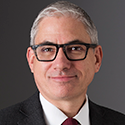
Opinions expressed in AGB podcasts are those of the speakers and not necessarily those of the organizations that employ them or of AGB.
Aired: March 7, 2023
University endowments are starting to take sustainable investing seriously, not only because students are urging them to but also because ESG—environmental, social, and governance—investing is proving to be good investment practice. For endowments looking to get started, or to expand their sustainable practices, this podcast addresses new opportunities as well as potential challenges, particularly in the context of the current economic and political environment.
In this podcast, AGB’s Executive Director of Philanthropic Governance David Bass speaks with Northern Trust Vice President, Director of ESG Sharee Hassan.
With more than 30 years of sustainable investment expertise, Northern Trust shares implications for the ESG landscape in 2023 and beyond.
Click to Read the Podcast Transcript
Introduction:
Welcome to the Trusteeship Podcast from AGB, the Association of Governing Boards of Universities and Colleges. We cover everything higher education leaders need to know about the challenges facing our nation’s colleges and universities. More important, we provide the facts and insight you need to solve those challenges and to be the storytellers and advocates higher education needs.
Today we’re talking about ESG, environmental, social and governance investing. University endowments are starting to take sustainable investing seriously not only because students are urging them to, but also because it’s proving to be good investment practice. For endowments looking to get started or to expand their sustainable practices, this podcast will address new opportunities as well as potential challenges, particularly in the context of the current economic and political environment.
In this podcast, AGB’s executive director of philanthropic governance, David Bass, speaks with Sharee Hassan, vice president, director of ESG for Northern Trust. Sharee leads the development of ESG investment capabilities within Northern Trust Wealth Management’s investment practice. With more than 30 years of sustainable investment expertise, Northern Trust will discuss implications for the ESG landscape in 2023 and beyond.
David:
Sharee, thank you very much for joining us today. Let’s start with a basic question. What is sustainable investing and, part two, how does it fit into the larger spectrum of ESG investing?
Sharee:
Thank you, David. I’m really excited to be a part of the conversation as many investors, especially universities and colleges, want to know what sustainable investing is. And when I think about the definition, sustainable investing is an investment solution based on the philosophy that environment, social and governance—ESG analytics—can complement quantitative or fundamental investment techniques to mitigate risk or to capture new opportunities.
You asked how does that fit inside of that broad umbrella? Well, under sustainable investing there are a number of different approaches that investors can take. They could either use ESG analytics in their portfolios or if they want to address a certain pillar, whether that’s the E, the S, the G, by taking certain approaches such as excluding companies from their portfolios based off of their business development or integrate them in based off of their ESG risk. That helps investors give them optionality between the approaches that they can take into consideration when adopting sustainable investing strategies.
David:
So sustainable investing is both a means of aligning your endowment management with institutional values and commitments, and a way to understand and manage risks and opportunities stemming from ESG factors.
The 2021 NACUBO TIAA study of endowments found that most higher-ed endowments—more than 80 percent—have added ESG factors to their investment policies as a first step in establishing a responsible investing approach. What is the current landscape from your perspective for sustainable investing for higher ed endowments and how can colleges, universities, and affiliated foundations leverage their peer groups to learn what other institutions are doing to advance sustainable investing strategies?
Sharee:
Institutional investors remain the highest adopters of ESG. Educational institutions specifically are the third largest of that group. The Forum of Sustainable and Responsible Investments found in 2022 $528 billion in assets from educational institutions that was reported. That was a 40 percent increase on top of the previous reporting year back in 2020. When I think about the reason why institutional investors, especially education institutions, are adopting sustainable investing, 75 percent of them do so to align their portfolio with their values. That was reported by the 2022 ESG Callan report. 63 percent of these investors do so to address stakeholders’ concerns. These are students, these are staff members and donors who have addressed and raised ESG as an issue they would like to see reflected in endowments’ investments.
One way universities and institutions can look to their peer group is by, as you’ve stated, David, 80 percent of them are integrating ESG within their investment policy statements. There are resources that university and colleges can use such as Intentional Endowments Network that looks at—it has a library of case studies for investors to use for universities that have gone down the path of adopting sustainable investing, in addition to there is a library dedicated to investment policy statements. So you can see how other universities have also verbalized ESG investing within their investment policies. For those investors who are more interested in a specific ESG issue, there are other organizations available, like the Principles of Responsible Investing which 25 percent of US investors have become signatories of. We’ve also seen a number of investors who’ve become signatories of investor-led initiatives such as Climate Action 100+, which has about 700-plus investors with $70 trillion into assets all geared towards engaging with the largest carbon emitters on their climate change.
David:
The NACUBO study data I cited earlier indicates that a lot of institutions are just now adapting their investment policies as a first step in establishing a responsible investing approach. What are the recent trends you’re seeing in ESG for universities and colleges? What sorts of different approaches are they taking and how do you see those playing out going forward?
Sharee:
Climate is everywhere as one of the concerns for university endowments. For the first time, institutional investors reported climate change and carbon emissions as the leading issue they want to address. This affects 52 percent of an increase of assets that were allocated to in 2020 versus the previous reporting period in 2022. When I think about climate change, many investors have, especially within the education space, addressed climate in a multitude of ways, whether that is completely divesting from fossil fuels, some like to utilize integration to be able to reduce their carbon footprint by 20 to 25 percent, even 50 percent. We’ve also seen investors take a thematic approach, meaning they are adding strategies that are more climate themed and aligned with climate change. We’ve also seen investors utilize stewardship as a tool that they can engage with companies and corporations on climate change.
I mentioned Climate Action 100+, which is a collaborative initiative amongst investors who really dedicate to engaging with those large corporate emitters on governance around climate at the top of the house. They’re also engaging on transparency around climate reporting, aligning with the Paris Agreement and also reducing their carbon footprint. So certainly climate comes up as a theme.
Also, under the social pillar a theme that comes up not surprisingly through the pandemic is human capital management. One of the things that came up is employee health and safety, “Do employees have the time to take off if they’re sick?”
Another social theme that comes up under human capital management is diversity, equity and inclusion. One of the commonalities that we’re seeing from universities within the sustainable themes, especially when it comes to climate and diversity, equity and inclusion, is they’re already doing the work within their institutions.
Sustainable programs that have come out through universities and colleges preparing students to take up careers within sustainability. And by investing in companies who are also being mindful of their ESG risk and having ESG initiatives, they’re preparing a pipeline of students in order to take those positions within the organization.
Even from a diversity, equity and inclusion standpoint, there has been a demographic shift within students, faculty and staff. When you’re looking at your student population and you’re also invested in companies who prioritize diversity as much as you do, you’re also being able to feed that pipeline of students into a diversified workforce with the same diversity that you’re seeing within your classrooms. When students are graduating, one of the top things that they look for at an organizations is a company that has an inclusive culture, a company that has representation in their diverse leadership so being able to be invested in those companies that prioritize ESG issues in those initiatives is an additive for many investors.
David:
I completely agree, Sharee. The recent AGB Foundation Leadership Forum, climate change and carbon neutrality and manager diversity really rose to the top of the, the issues that our foundation members were looking at in terms of their endowment portfolios. Another issue, obviously, that they’re being responsive to is donor interests. The fastest way to grow your endowment is obviously new gifts, and a lot of donors have been expressing interest in the ways in which their endowment gifts will advance institutional commitments to climate change and manager diversity though its investment portfolio as well. As you’ve suggested, there’s a lot of different ways that institutions are coming at this these days. What are some of the biggest impediments that boards face when incorporating ESG factors into their investment policy statements and their decision-making around implementation of ESG factors?
Sharee:
The greatest question that comes up about ESG and implementation is performance. That is why we believe every strategy regardless or not if it’s ESG should be measured on the metric of performance.
When investors look to align their portfolios with their values, you have to determine what in the strategy is being additive to the performance. Another way to address this is to ask, “What are the drivers of performance?” And a great way to answer that question is to be able to observe solutions that stand on its own merit. That means if you take off the label of ESG from a strategy, can it perform in line with its peers regardless or not if it’s ESG? What we’re finding is that many investors are not integrating ESG more so as an alpha driver to improve their alpha. We’re seeing that they’re integrating it to, again, look at those risk and mitigate the risk and capture new opportunities. Earlier, David, I mentioned the 2022 Callan report which did find that 38% of endowments are integrating ESG to improve their overall risk profile, and that’s important when we’re having this conversation to know even when we’re thinking about performance to also understand how ESG is helping mitigate risk and capture new opportunities for investors.
David:
You pointed to the value of ESG strategies not only as an alpha driver, but as a risk mitigation strategy, and in talking about the impediments boards face, you immediately jumped to the question of performance. What questions should boards be asking about how they assess performance when looking at their ESG portfolios?
Sharee:
I would say that the question they should be asking is, “How can we view the different risk in our portfolio from an ESG perspective?” And what we find is we need more sustainable tools with the emphasis on ESG reporting. Many of our clients, especially within the university and college space, want to view their portfolio though a ESG lens. They want to see what ESG risk their portfolio is exposed to, and that is why we’ve partnered with MSCI as ESG research to help our clients be able to gain additional insight into ESG factors beyond the traditional financial view. This data provides investors with a broad set of datasets from the fund level to company specific information on ESG data points, whether that is ratings or ESG controversies or business involvement, certain things that investors are interested to see. I call it looking at your portfolio with a pair of glasses. With the right tools, you can measure aspects of ESG to get a clear picture of your overall risk that you’re exposed to within your portfolio.
David:
Sharee, you mentioned the, the value looking at ESG factors of adding an additional lens to better understand the risk and better manage the risk of a portfolio. Obviously people present the biggest area of potential risks, and so many institutions now rely on outsourced chief investment officers, OCIOs, as well as traditional investment consultants and other investment service providers. What are some of the due diligence questions that boards and committees should be asking specifically in relationship to providers of investment services related to ESG policy and implementation?
Sharee:
When looking for a financial partner, some of the areas that I would point out would be helpful is understanding the overall firm’s commitment when it comes to sustainability. If you are interested in a strategy or interested in taking a sustainable approach, it helps partnering with an organization that is already down the path of integrating sustainability within their own business, whether that is reducing the carbon footprint of their organization or certain diversity and equity initiatives that they promoting within the company. You can also look at organizations to understand their investment process. Look through to see their sustainable investing platform and to understand their reporting capabilities, ensuring that you’re able to meet both your financial and your sustainable investing goals.
What we find many investors come to us and they ask, “Well, how can I feel confident in having strategies selected knowing that it’s going to demonstrate a clear commitment to sustainability rather just being labeled as one?” And one of the areas that we touch on specifically within our strategy due diligence process is our ESG strategies goes under the same due diligence that is required to verify the approaches that many of our third-party strategies have. We’re able to utilize third-party research to be able to assess is strategies are showing the exposures that is put forth within the strategies methodology.
Another way investors can look to financial institutions is finding ways of how they can go about selecting their investment strategies and understanding the spectrum of approaches that they offer. By having deeper conversations with experts within the organization, by working with a trusted financial advisor, they’re able to help you select strategies that best fit your sustainable needs and we find many investors being able to communicate the way that they’re investing to those stakeholders, whether that is students, staff or donors. By codifying these expectations, it allows you to have a deeper conversation with your service provider to be able to draw out what you would like to achieve.
David:
To wrap up, I’d like you to share a few pieces of any advice that you would give to boards and investment committees considering sustainable investing.
Sharee:
There’s five pieces of advice that I would give to investment committees. One of the things that they’re doing already by listening to this podcast is understanding exactly what ESG investing is and helping define some of the trends and themes that are coming up within this space. By bringing in an ESG expert, it can help you define your sustainable investing focus and understand the different risks that come up within your portfolio that many committees may want to address.
Establishing goals is a next step as defining the sustainable investing goals that you want embedded in your investment philosophy, and more so in your, um, investment policy statement. Earlier on, we talked about, like, how we’re seeing a multitude of investors, 80 percent, who are integrating sustainability in their investment policy statement, and by doing so you really have to be able to establish the goals that you’re trying to meet.
The third is determining an approach to select an investment. There is a spectrum of approaches that investors can take when adopting sustainable investing and they’re not mutually exclusive. They can integrate, which has been one of the most popular strategies here in the US, or they can choose to have a thematic approach or use stewardship. So there’s a number of mechanisms that investors can use to integrate sustainability within their portfolio. It helps to understand the approaches, the many approaches, that one can take within sustainable investing, and we’re also seeing investors use this step as a way of understanding how they want to allocate within their portfolio to sustainable investing. Some want to carve out a specific sleeve, whether that is working with equity or fixed income. Some decide to work within a specific allocation, whether that’s integrating 10, 20, 100 percent of their portfolio to sustainable investing strategies.
The last two steps are selecting investment strategies using the guidance from your financial partners experts to help guide you to strategies that meet the goals of your organization and what you’re trying to achieve in your portfolio.
And lastly, communicate, document, refine. Define an ongoing plan to help you assess within your approach, use education and stay up to date on ESG trends, thought leadership—I know AGB has a ton of thought leadership on this topic. And also look at capabilities that you’re able to offer up to your committee members and stakeholders to be able to communicate the work that you’re doing within your portfolio.
So those that five steps together we find are helping investors as they’re starting down the path, or if they’ve already done so going and continuing down the path of adopting sustainable and investing within their overall strategy.
Conclusion:
Sharee and David, thank you so much for your insight today on ESG investing. AGB thanks Northern Trust for its partnership and support of AGB. For more information on Northern Trust, please see northerntrust.com.
Speakers

David Bass serves as AGB’s executive director for philanthropic governance, providing thought leadership on board governance and leadership best practices that relate to philanthropy in higher education. He oversees the development of programs and resources supporting institutionally related foundation boards, institutional governing boards, and other senior staff and volunteer leaders of higher education fundraising and stewardship. David previously served as AGB’s director of foundation programs and research.

Sharee Hassan is the vice president, director of ESG for Northern Trust, where she leads the development of ESG investment capabilities within Northern Trust Wealth Management’s Investment Practice. She is responsible for providing ESG education to clients and partners addressing a wide variety of ESG investing techniques, solutions, and key market trends. She works closely with North American investors, such as high-net-worth individuals, families, foundations, and endowments on their ESG objectives.
RELATED RESOURCES

Trusteeship Magazine Article
Trusteeship Trends: Fiduciary Duties and ESG Investing



